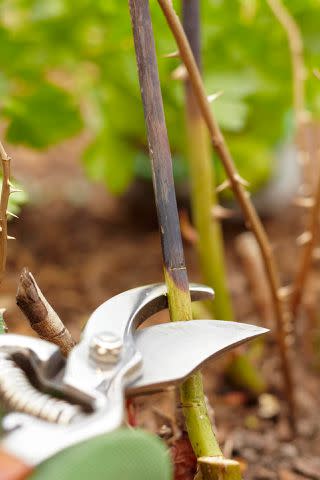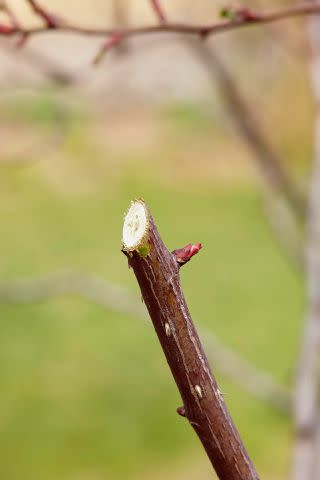How to Prune Roses of Every Type to Maximize Blooming
Keep your rose shrubs, climbers, heirlooms, or modern hybrid roses looking their best with these time-tested tips for trimming back your roses each year.
Roses have a reputation for being difficult to prune. But don't let their prickly limbs and sometimes unruly growth habits intimidate you into believing this misconception. Once you've learned the simple step-by-step process for shaping up these beautiful plants, you just might find yourself looking forward to your rose pruning tasks as a relaxing activity, like I do. Plus, you'll see almost immediate rewards, such as an expanded yield of blooms throughout the season; healthier, more long-lived plants; and a much more elegant-looking garden. So pull on a thick pair of gauntlet gloves, grab your favorite pruning shears, and keep these tips in mind while you're clipping back your roses.

When to Prune Roses
Plan to give your roses a good pruning at least once a year. For once-blooming rose varieties, wait until early summer to prune them, just after they've bloomed. They can be shaped up a little more in late summer, but beyond that, pruning healthy stems (also called canes) will reduce the number of blooms you get next year. For most other types of roses, the best time to prune them is in late winter or spring, right after your last frost date. You'll want to track your local weather forecast because late frosts can vary by weeks or even months from year to year. Though it's not something to stress over, optimal timing will help prevent injury to your plants and save you from having to repeatedly prune out new cold damage.
:17 Super Fragrant Roses That Will Fill Your Garden With Sweet Scents
You may also find it worthwhile to do a lighter summer pruning to remove faded blooms. This helps keep your garden looking tidy and also prepares your roses for a stronger fall bloom. If you prefer a crisp, clean-looking winter garden, you can deadhead very lightly again in fall. But be aware that pruning can stimulate new growth and prevent roses from going dormant in time for harsh winter cold, which can lead to winter damage.

How Much to Prune Back Roses
There are a few different approaches to pruning roses, depending on what you want to get out of them and what type of rose they are. Newly planted roses should be only lightly pruned, if at all, their first year so they can spend more energy on establishing strong roots instead of growing stems and leaves. For older, healthy roses, you can experiment with any of the 3 following styles.
A light pruning removes less than a third of the plant. If a rose has a nice natural shape with good bloom and little disease, you can be very selective about your cuts.
A moderate pruning cuts the plant down to 18 to 24 inches high with 5 to 12 canes coming from the base. Do this if you want to improve the branching structure of your plants, which will encourage new growth and better flowering.
A severe pruning takes roses down to 6 to 10 inches in height and 3 to 5 canes. It is ideal for long-stemmed flowers like classic hybrid teas, or just to refresh any older plants that are not performing well. Keep in mind that some varieties may not bloom well right after being cut back this much. Instead, they may focus on regrowing stems that may not bloom until the next year, even if the rose would normally repeat bloom all season.
Climbing roses are an exception. If they've gotten overgrown, you can drastically reduce their overall size by removing excess canes at the base of the plant, but you should leave at least 3 to 5 canes and don't cut them shorter than 5 feet.

How to Prune Roses, Step by Step
Even after you decide how much you want to prune your roses, it can seem hard to know where to start. Use the following steps as a guide for what you should remove, in order of priority. Make all final cuts at a 45 degree angle above an outward-facing bud eye, pictured above. You don't need to seal most cuts because the plant will take care of that itself, but some gardeners like to use a dab of white glue on cut surfaces to help prevent disease and pest problems such as cane borers.
Remove dead branches and canes. Cut back to live wood; it usually looks green on the outside.
Prune diseased or damaged branches back to healthy wood.
Clip away branches that cross through the center of the plant.
Remove any growth that is much thinner or weaker than the rest.
Remove suckers from the base of grafted roses.
Take out older woody growth, unless it would thin out the plant too much.
If any remaining branches rub against each other, cut away the smaller ones.
Lastly, you can shape to taste, adjust the overall height and width. Shaping the top of the plant into more of a rounded dome rather than a flat top encourages flowering from top to bottom.
As you work your way through these cuts, remember that roses are vigorous plants that are hard to hurt. In most cases, any mistakes you make will be quickly repaired by new growth. When you're all done, it's time for what may be the most difficult part: clean up. The easiest way I've found is to rake clippings into a large makeshift dustpan such as a cardboard box. Then, you can step back and watch your roses thrive and bloom for another year.
Frequently Asked Questions
What tools do I need to prune roses?
<p>The exact tools you need to prune your roses will depend on the size and type of rose bush you have. Some smaller or more delicate rose bushes can be trimmed using only pruners, while others need more hefty gear like electric hedge trimmers. In addition, you'll want to wear gloves to protect yourself against painful thorns.</p>
What happens if I don't prune my roses?
<p>Leaving your rose bush to fend for itself instead of regularly pruning it can ultimately lead to its demise. Rose bushes thrive on care and will be more productive and healthy with regular pruning. A lack of pruning can lead to more incidence of disease, pests, and fungus.</p>
Can I cut back an overgrown rose bush to the ground?
<p>As a general rule of thumb, you should not prune your rose bush back more than 1/3 to 1/2 of its overall size. Doing so can cause the plant to go into shock, often leading to an untimely death.</p>

